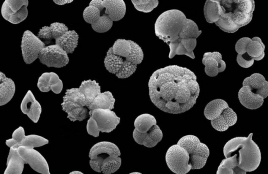Understanding past global warming events
Extraordinary moments in climate history are interesting to explore; you could come across useful information for our current situation. NESSC researcher Cindy Schrader is investigating temperature peaks called hyperthermals dating 50 million years back. How did these rapid warming events arise? And what factors led to global cooling again?
Many hyperthermals occurred during the Early Eocene Climatic Optimum (EECO), the period Cindy is particularly interested in. ‘There is a lot of research going on about this subject, because hyperthermals are interesting moments that can tell us more about the way climate can change in a very small time frame’, says Cindy. ‘Those hyperthermals were probably the fastest large increases in temperature of the last 65 million years; therefore, it’s interesting to compare them to the current warming.’ The only problem: research often focuses on the largest hyperthermal called PETM. Data about other, smaller peaks are virtually non-existent.
Fossils and climate conditions

That is why Cindy’s work revolves around completing the historical climate archive. She uses stable isotopes in planktonic fossils to identify the climate conditions. If you take a core sample from the sea floor, you’ll find fossil remnants of plankton and other sea-dwelling species. The deeper you drill, the older the fossils. Those fossils can be used to analyze the ratio of different versions of the same atom, called isotopes. The ratio of different oxygen isotopes you find in a fossil, for instance, can tell you something about the temperature and salinity in the period that the animal was alive. Stable isotopes can fill the gaps in climate history.
Picking the right fossils out of a sample – for Cindy’s research, you’ll need species of formaminifera – isn’t that easy. Cindy: ‘You need a drill core that matches the time period you want to investigate. Then you need to slice it and wash it, so you are left with only the forams. When you dried your sample, you can put it under the microscope to pick out the right forams. Not all species are suitable for this research, so you need to learn to identify the ones you need. For one isotope test you need at least 15 forams. If you managed to pick out enough of the right forams, you can grind your sample and put it in a mass spectrometer, a device that measures the ratio of different isotopes in a sample.’
To be even more sure of her results, Cindy uses a second method to get data from her forams. In Santa Cruz, USA, she is currently working with a method to analyze the ratio of magnesium and calcium in her samples. ‘That ratio also tells you about the temperature, just like oxygen isotopes, but it is not influenced by salinity. These data can therefore validate my other results.’
Playing a detective

There is not much known about the hyperthermals during the EECO. It’s nice to research those, says Cindy, because we need to find out how they worked. ‘Those hyperthermals are not a hundred percent equivalent to today’s situation, because the current temperature has a much steeper slope. But still, it’s interesting: if there were certain triggers that made the temperature rise quickly, after a specific threshold was reached – they might apply for our situation as well.’
Of course, a point-by-point comparison to today’s climate isn’t possible. But with more information about the past, we can better understand our climate system. And make more adequate models to predict the future.
‘That’s what makes investigating a period of million years ago attractive. It feels like the work of a detective. Everything affects everything. You’ll have to think very carefully about the whole system.’

